Movie Retrospective: Picnic at Hanging Rock
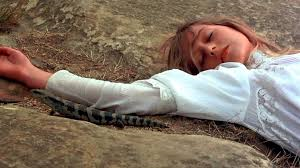
Peter Weir’s majestic 1975 film Picnic at Hanging Rock opens appropriately with some lines from Edgar Allan Poe’s poem A Dream Within a Dream. The pervading sense of mystery and ambiguity is one of the many hallmarks of this Australian film based on the 1967 book of the same name by Victoria’s own Joan Lindsay. The motifs of evolving adolescence and covert sexuality are suggested in the film’s opening images at the all-girls private school of Appleyard College near Mount Macedon. It’s St. Valentine’s Day 1900 and the teenagers awaken to a beautiful summer’s morning which promises happiness and celebration. Accompanied by some striking panpipe music, the viewer is introduced to them as they recite poetry in honour of the feast, press flowers and gleefully whisper secrets to one another. There is a particular early focus on the characters of Miranda (Anne-Louise Lambert) and Sara (Margaret Nelson). The younger girl is evidently besotted by her roommate who invites her to come visit her home some day. A note of warning and impending departure is struck however as Miranda reminds Sara that their friendship cannot and will not last forever – ‘You must learn to love someone apart from me Sara.’ Weir also subtly conveys some of the associations and alliances which exist at the college apropos its teachers and students. When Miss McCraw (Vivean Gray of The Sullivans and Neighbours fame) exits the school building, we see her pause and react somewhat as she spots her colleague Mlle. de Poitiers (Helen Morse) chatting amiably with a group of girls. At the very top of the building, Sara stares down dolefully as Miranda and the others depart. The subject of some displeasure for the headmistress Mrs. Appleyard (Rachel Roberts), Sara has been denied the pleasure of the day’s outing and must remain at the school.
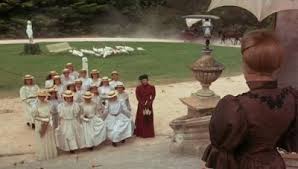
The chaste nature of the sexuality on display here, as well as the social divide between the privileged school and the local community, is conveyed by Weir as the girls remove their gloves as soon as they have passed through the nearby town. As they approach the geological formation a sense of excitement is engendered, but there is also a smattering of the foreboding which is unmistakable. Opening a gate which leads into the public grounds of the rock, Miranda is struck by the sight of numerous birds flying away as if startled by something. The horses drawing the carriage react in a similar fashion. The world of nature appears to be in a state of unease and a short time later several of the party discover that their watches have inexplicably stopped at the precise hour of midday. Searching for a rationale explanation for this, Miss McCraw reasons that it must be, ‘something magnetic.’ But even she isn’t entirely certain and the abiding feeling of some other-worldly influence remains.
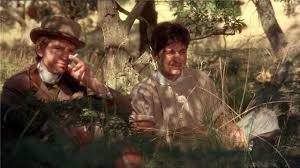
The girls and their teachers are not quite alone on the rock as a smaller party consisting of a young Englishman Michael Fitzhubert (Dominic Guard), his aunt and uncle, and their somewhat unrefined but goodhearted valet Albert (John Jarratt) are dining close by. Again, there is the minutest of allusions to a class divide as Michael accepts Albert’s offer to share his beer with him. Back at Appleyard College, Sara is reprimanded for not having learnt her poetry. ‘Bertie! Bertie! Jesus, where are you?’ she whispers to herself in the first mention of her missing family member. A much greater revelation in this respect follows later in the movie which I will come to in due course. If you have seen the film previously, then you should know what I’m referring to. If not, then one of the aforementioned character names might just give you a clue.
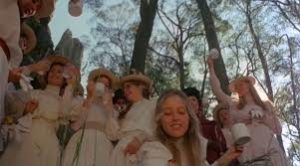
Three of the girls, including Miranda, request if they can explore the rock a bit further. ‘We shall only be gone a little while,’ the pretty blonde promises her French teacher. As she departs, she turns back briefly and waves in one of the film’s most indelible images. ‘Now I know,’ Mlle. de Poitiers remarks as she watches Miranda and the others disappear into the distance. ‘What do you know?’ enquires the bookish Miss McCraw. ‘I know that Miranda is a Botticelli Angel,’ de Poitiers replies in a line which references art and also hints at the underlying artistic endeavour of Weir and his cinematographer Russell Boyd. The works of Australian Impressionism, particularly that of Frederick McCubbin’s piece Lost, were a definite influence on the film’s themes and visual style. Boyd himself stated in a subsequent interview that the ethereal look of the picnic sequence was created by placing simple bridal veil fabric over the camera lens. The pervading sense of sexuality as a distinct undercurrent is maintained as the girls attired in white are watched by Michael and Albert as they cross a small brook. The young English gentleman reacts ever so slightly to the crude remark of the Australian, but is silent as Albert points to a general truth and distinction between them – ‘I say the crude things, you just think them.’ Of no small significance also is Albert’s mentioning of the orphanage in which he was raised with his ‘kid sister.’ On the premise of wishing to ‘stretch his legs,’ Michael follows the girls across the brook, but Weir never specifies just how far up the rock he pursues them. Boyd’s camera frames the four girls (Miranda, Marion, Irma and Edith) from below and also from the perspective of an unseen other party. There is an especially memorable shot as the camera leaves the girls, does a 360-degree pan, and returns to them as they continue on their upward journey. One of the most striking elements of the cinematography here is the suggestion that the girls are being watched by someone or something. The tone and spirit of their innocent adventure shifts perceptibly as the indolent and overweight Edith complains of the inhospitable surroundings as she perceives them – ‘I never thought it would be so nasty or I wouldn’t have come!’
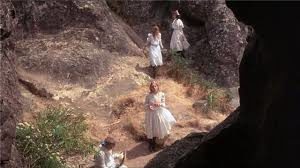
With the notable exception of Edith herself, the girls remove their shoes and tights. ‘Everything begins and ends at exactly the right time and place,’ Miranda remarks before she and the others lie down in the warm glow of the sun. A haunting moment follows as the three barefooted girls wake up and walk through an opening in the rock in an apparent trance-like state. ‘When are we going home?’ Edith demands, but she receives no response. ‘Miranda, don’t go up there! Come back!’ she screams as she experiences a manifest forewarning of danger. One of the film’s most haunting images – which is shot from an overview perspective by Boyd – shows her running back down the rock in a state of some distress. It’s a wonderful juxtaposition to the slow and almost methodical movement of her three classmates as they are lured by some unknown power or influence. It’s also quite a jolt in its visual impact, but Weir’s intent is clear-cut and fitting; he is not in the habit of cheap tricks or shock tactics.
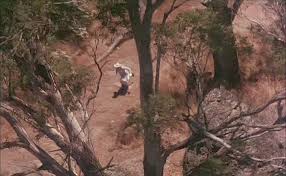
The remaining party return much later that night to Appleyard College where the anxious headmistress is informed that three of the girls and Miss McCraw have disappeared on the rock. A search is initiated by the police under the stewardship of Sergeant Bumpher (Wyn Roberts). Edith refuses to answer his questions (‘Was there a man?’), but the local doctor assures Mrs. Appleyard that the girl was not molested. Speculation and rumour become the order of the day in the small community and this is reflected in a telling scene which takes place between Bumpher and his wife – ‘They couldn’t be local,’ she surmises in such a vein, ‘no one around here would do a thing like that.’ Rape, abduction and even murder are assumed as most likely explanations. Retracing her steps on the rock with Mlle. de Poitiers and Sergeant Bumpher, Edith reveals by chance the fact that she had seen Miss McCraw going up the rock in a great deal of haste just as she was coming down. ‘She was funny,’ she remarks. When pressed by Bumpher and her schoolteacher on this point, the girl discloses that the normally respectable Miss McCraw was not wearing a skirt.

The search takes on an increasingly desperate aspect as the girls and their mathematics teacher remain missing. Michael is again questioned by Bumpher as to what he saw on the day in question and, more pertinently, why he had not previously stated that he had followed Miranda and her friends. Insisting that he had turned back after a short time, the young man’s obsession with the attractive girl grows. Weir presents the striking image of a swan (a clear metaphor for Miranda and her incomparable beauty) as Michael tells Albert of his decision to search for the girls himself. His Australian friend is dubious of such a venture to say the least and posits the force of nature as a basis for his argument – ‘A week in the bush, they’d be dead by now.’ Nevertheless, he accompanies Michael to the rock and they search it inch by inch. Despite Albert’s protestations, Michael determines to stay out for the night. One of the film’s most eeriest sequences (almost on a par with our last sighting of the girls) follows on the next day as the physically exhausted Michael falls asleep in the sun and dreams of Miranda and her party disappearing all over again. In vain he struggles to make it to a recess in the rock face – perhaps the same one which the three girls had entered. Down below, Albert returns and follows a paper trail which Michael has left behind him. He finds a visibly delirious Michael who is cut and bruised and suffering from exposure. The injured man is brought down by the police, but leaves Albert with a vital piece of material – a fragment of white lace from a dress. Albert discovers the body of Irma who is still alive. From the very top of the rock, he calls out to the police carriage which is bearing Michael away.
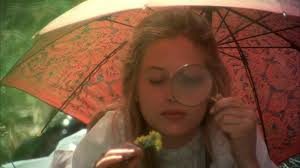
The considerable effects the deepening mystery is having on the local community in Woodend are again relayed as a discontent group of townspeople gather outside Bumpher’s house. Mrs. Appleyard, for her part, also refers to this in another way as she informs the rather edgy Miss Lumley that several of the girls will not be returning to the school the following term. Terming the mystery, ‘our morbid little affair,’ she wonders what the local and international press will choose to ‘sensationalise’ next. The rescued Irma convalesces at the Fitzhubert home and is visited by the police sergeant. The puzzled doctor informs him that the girl’s minor cuts and bruises are entirely inconsistent for one who was a full week in the bush – ‘I’d give my head to know what really happened up there.’ Irma has no recollection of the events of the day and can present no clue as to the location of her friends and teacher. She befriends Michael and they spend some time together, but it is evident that his thoughts are still centered on Miranda. ‘The summer will soon be over,’ she remarks as they take a boat trip together, ‘it’s sad really, like someone dying.’ Michael asks her what happened on the rock, but she declines to answer. Soon afterwards, he tells her of his plans to go away again. Upset by this news, she runs off.
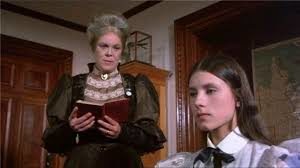
The character of Sara takes on an even greater prominence in the film as her own personal situation worsens. Bereft now of her closest friend, the solitary girl is informed by Mrs. Appleyard that she may have to return to an orphanage as her guardian appears to have deserted her. Boyd’s atmospheric use of lamplight is perfectly captured in the scene in which Miss Lumley finds her sitting on the stairs staring up towards the heavens. Taking to her bed in an apparent illness, Sara tells one of the college staff Minnie (Jacki Weaver) about how she had her head shaved when she misbehaved in a previous orphanage. Two incredibly tense scenes follow – the first as the girls depart from a Sunday Service and are observed with some hostility by the townspeople; the second occurs as Irma visits her schoolmates during a dance lesson and is confronted by them in a near frenzy as to what happened on the rock – ‘Tell us Irma! Tell us!’ Intervening to prevent any further such hysteria, Mlle. de Poitiers discovers – to her horror – that Sara has been strapped to a wall to correct her posture. The unhinged Mrs. Appleyard (who is secretly drinking on an ever more frequent basis) visits Sara in her room late one night and informs her that she is to be sent back to the orphanage. A scene – which is very reminiscent of Weir’s later film Dead Poets Society – takes place as a faintly smiling Sara determines on her next course of action. The aura is hauntingly indelible as she rises from her bed. Outdoors, there is the unmistakable sound of breaking glass. Soon after, a figure enters the girl’s room again and begins to pack her personal belongings – a reflection in the mirror reveals it to be Mrs. Appleyard.
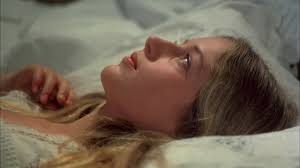
I alluded to an important narrative thread which Weir and the screenwriter Cliff Green planted earlier in the film and this is illuminated in a subsequent scene which takes place between Michael and Albert. The latter describes a dream he had the night before in which he detected the aroma of pansies. He explains how he had a vision of his ‘kid sister’ whom he hasn’t seen since the orphanage – ‘Goodbye Bertie she says. I’ve come a long way to see you and now I must go. And she went. Clear through that wall over there.’ He calls her by name for the first time in the film – Sara. At the school, Mrs. Appleyard informs Mlle. de Poitiers that Sara has left with her guardian who turned up unexpectedly. It’s the end of term and the girls depart on their holidays. Over dinner the inebriated Mrs. Appleyard talks aimlessly about her memories of holidays in Bournemouth when her husband was still alive. When asked about Sara by Mlle. de Poitiers, she ignores the question, but, in a heated moment, expresses her disgust at Miss McCraw for allowing herself to be, ‘lost and raped like a silly schoolgirl.’
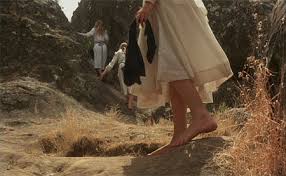
The following morning the old gardener makes a grim discovery in the glasshouse beside the school as he finds Sara’s body among the plants. Seeing no future and no hope, the girl has taken her own life; presumably also in an effort to be reunited with her beloved Miranda in the afterlife. Mrs. Appleyard is dressed all in black as he tells her the horrific news. Slowly, she turns and faces the camera without a word. A clock on the mantelpiece stops dead just as the watches had previously done at Hanging Rock. A flashback to the fateful day is accompanied by the off-screen narration of Bumpher – ‘The body of Mrs. Arthur Appleyard, principal of Appleyard College, was found at the base of Hanging Rock on Friday the 27th of March 1900. Although the exact circumstances of her death are not known, it is believed she fell while attempting to climb the rock. The search for the missing schoolgirls and their governess continued spasmodically for the next few years without success. To this day, their disappearance remains a mystery.’ The film concludes appropriately with the unforgettable image of Miranda as she waves goodbye to Mlle. de Poitiers once more. In slow motion, she turns her head and is forever lost as the screen turns white and then fades to black.
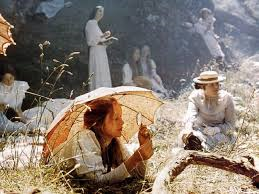
2017 marks the 50th anniversary of the publication of the original novel by Joan Lindsay on which the 1975 film is based. Widely regarded as one of the most important Australian novels of all time, the book has not been without its controversies and debate over the years owing to its framing and ambivalent presentation as a true story. Lindsay, a visual artist as well as a writer, spoke of her fascination with the rock and put pen to paper following recurring dreams on the subject. She cited the work of Henry James as an important influence and there is certainly a distinctly Gothic feel with respect to the story’s combination of elements such as fear and suspense. Much of the discussion has centered on the unresolved conclusion and the form the book generally takes, postulating itself as an actual historical event; to reinforce such an effect, Lindsay begins and ends the narrative with pseudo-historical references. Criticised in some quarters for such an approach, the novelist defended herself in a 1974 interview saying – ‘Well, it was written as a mystery and it remains a mystery. If you can draw your own conclusions, that’s fine, but I don’t think that it matters. I wrote that book as a sort of atmosphere of a place, and it was like dropping a stone into the water. I felt that story, if you call it a story – that the thing that happened on St. Valentine’s Day went on spreading, out and out and out, in circles.’
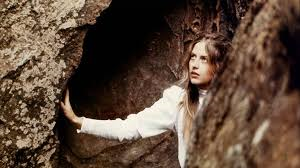
This is certainly an aspect of the story which Weir’s film picks up on as we see the reaction first of the school’s authorities followed by those of the wider community. Class distinctions are also picked out – as I’ve suggested – in the relationship between Michael and Albert, as well as an overt chasm between the privileged young ladies of the school (‘rolling in money,’ as one character unceremoniously puts it) and those who are employed by the establishment and work the land (Sara Waybourne – the tragic orphan is, of course, the one exception in this regard). The atmosphere which Peter Weir and his production team (Russell Boyd most especially of all) evoke is one of the key reasons why Picnic at Hanging Rock lingers long in the memory. Roger Ebert hailed it as a, ‘film of haunting mystery and buried sexual hysteria’ – as it most certainly is – but also set out its context in terms of Australian cinema as a whole when he noted that it, ’employs two of the hallmarks of modern Australian films: beautiful cinematography and stories about the chasm between settlers from Europe and the mysteries of their ancient new home.’ Comparisons between it and 1971’s Walkabout are not misplaced. Like the earlier Nicolas Roeg film, Picnic at Hanging Rock presents Australia’s diverse environment in stark contrast to the white population which has only recently come to inhabit it. The raw power and immutable force of nature is suggested by the rock formations lovingly photographed by Boyd and in the early scene in which the factually-fixated Miss McCraw talks about the geological formation which she surmises is, ‘barely a million years old.’ ‘Waiting a million years, just for us,’ Irma innocently remarks as she makes light of this particular detail. The Australian bush, as described by Lindsay, and subsequently captured by Boyd, is a harsh, unforgiving environment which the young girl cannot even begin to conceptualise. One of the few characters who appears to understand this is the somewhat unpolished Albert as he warns Michael about remaining on the rock overnight – ‘You’re a funny bugger,’ he remarks as he fails to dissuade the young gentleman. An inherent difference between the English and Australian sensibilities is underlined as Michael expresses his revulsion at the idea of leaving, of effectively giving up – ‘I know you lot are Australian…’ The English Empire may still be enjoying its heyday at this point in time, but this display of bravado on his part is foolhardy and almost very costly. It’s of no small significance, therefore, that the more practically-minded Albert (who is in tune with his natural surroundings) is the one who comes to Michael’s rescue and, consequently, Irma’s. The fundamental suggestion is that intrinsic Victorian mind-sets hold no sway in such a prehistoric and primal world.
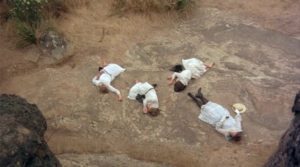
For the purposes of this article, I watched the original theatrical release of the film which is some eight minutes longer than the subsequent Director’s Cut. Of the two, it’s my preferred version as some of the scenes which Weir decided to remove add to character exposition and balance the narrative in a more harmonious way. I’m not for a moment suggesting that a sense of clarity and order is what I want anyone to take away from this wonderful film. Notwithstanding its pseudo-factual premise, Picnic at Hanging Rock works so beautifully because it is at once a compelling mystery and a potent reflection on the nature of loss. The inconclusive ending, involving Mrs. Appleyard’s death and the unsuccessful further attempts to locate the missing group, enhances an overall impression of impenetrability. Following Joan Lindsay’s death in 1984, a previously excised final chapter to the book was published posthumously as a standalone titled The Secret of Hanging Rock. The mystery is apparently resolved in these pages, but, I for one, have to say that I have no great desire to ever read it. I guess the truth of the matter is that – like so many other admirers of the book and film – I want the affair to remain an unknowable, an enigma. At times poignant, ever-enduring and not just a little unsettling, Peter Weir’s film is as good a screen adaptation as this haunting story deserves. In the immortal words of Miranda: ‘Everything begins and ends at exactly the right time and place.’
It’s perfect.
The pair – book and 1975 film – represent the most elevated art to which humankind has yet ascended.